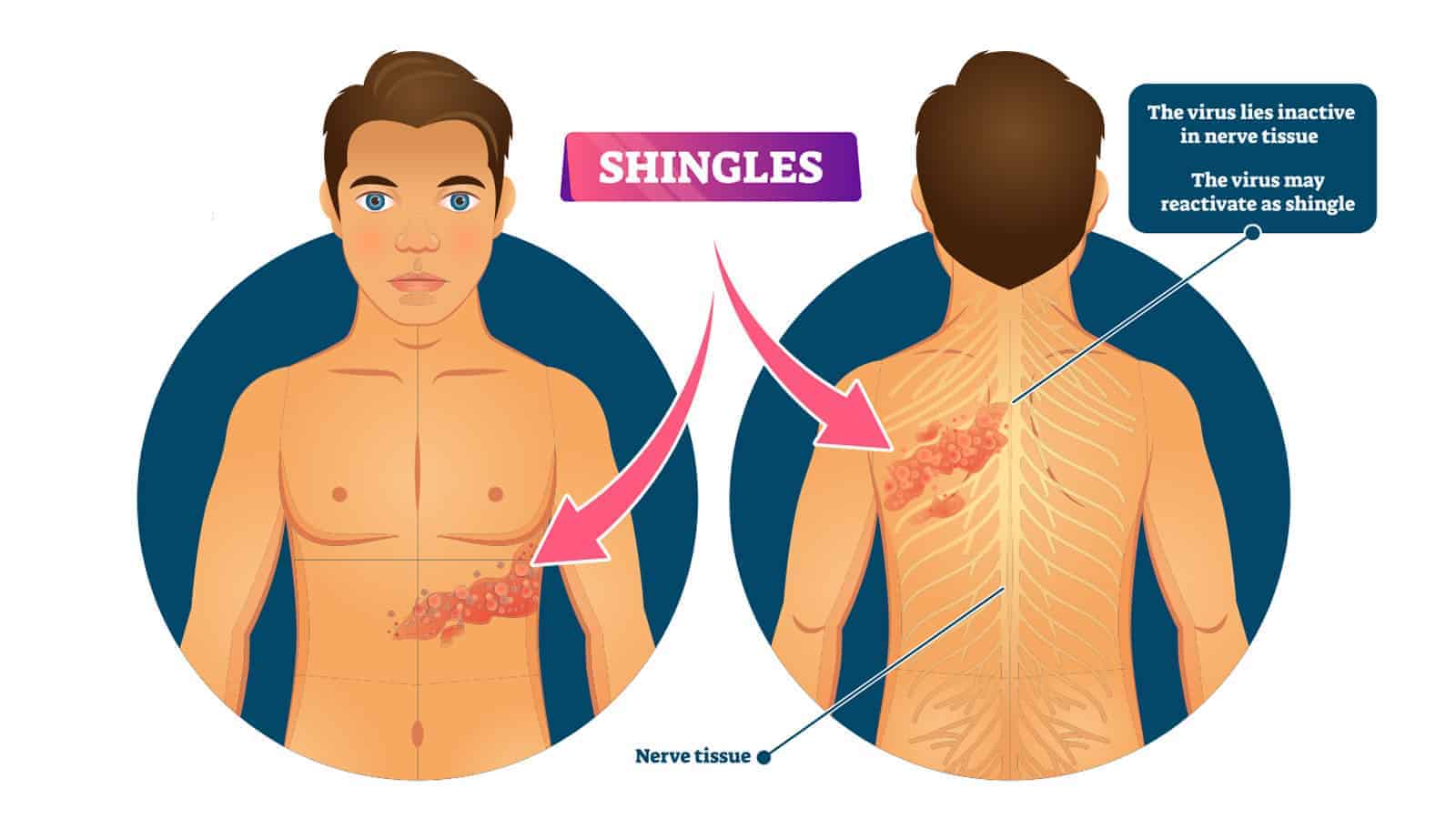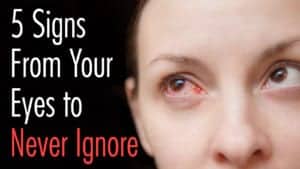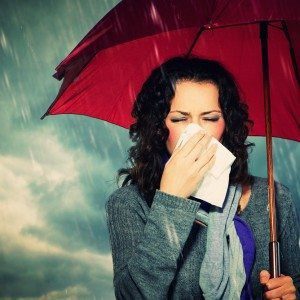Are you coping with a shingles breakout? This might not be of much comfort, but it’s no surprise…
That’s because the Centers for Disease Control and Prevention (CDC) estimates that 1 in 3 people in America will develop shingles sometime in their lifetime. The outbreak begins with blisters that become scabs after seven to ten days and are usually fully healed in two to four weeks.
The rash most commonly begins as a stripe around one side of the body, such as the waist, chest, abdomen, back, or sometimes the face. Hearing or vision can be affected when it occurs on the head, so it may be a good idea to visit your doctor for a quick recovery plan.
Studies have shown that internal organs may also be affected. Evidence of the virus has been found in the digestive system and the arteries in the brain. The results have been gastrointestinal distress and a possible increased risk of stroke or dementia.
Is Shingles Contagious?
Although generally not considered life-threatening, the virus can be contagious for those with a past chickenpox case. So, sufferers should wash their hands often, cover the affected area if possible, and avoid scratching irritated skin.
The virus can also cause chickenpox in those who have never had that illness, so contact should be avoided with infants, children, or pregnant women. Children and adults of any age can contract the shingles virus. However, adults over 50 years old and individuals with a compromised immune system or serious physical injury are at higher risk.
The Primary Causes of Shingles
Why this virus would suddenly activate after years of lying dormant is unknown. But at least some of its sources and possible impetus have been researched.
The Varicella-Zoster Virus
Shingles arise from a herpes-type virus called the Varicella-Zoster Virus (VZV), the source of common chickenpox. Because of this, some professionals refer to the condition as Herpes Zoster. Herpes Zoster is not a sexually transmitted disease. It can, however, be transferred by directly touching any open sores in the rash, so others should avoid physical contact.
From Childhood Chickenpox to Herpes Zoster
After having chickenpox as a child, the virus may lie inactive in nerve tissue near the spinal cord or brain. It can then reactivate as shingles years later. The virus travels along nerve pathways, eventually erupting on the surface of the skin. As a result, the sharp pain associated with the virus often results from nerve involvement rather than from the rash itself.
Of course, not everyone who has chickenpox will develop shingles. The reasons for the condition are unknown, but age and overall physical health are believed to help raise the chances of the virus becoming active.
Stress
Some studies indicate that extreme stress resulting from devastating events such as a financial calamity, injury, or loss of a loved one can weaken the immune system, causing the varicella-zoster virus to reactivate, resulting in shingles. Or ongoing daily stress combined with age, mood disorders, and poor diet may also cause reactivation.
Stress should never be underestimated in its effects on the body. Learning how to lessen the severity and duration of stress can be an important factor in promoting overall health and shorter recovery times.
Eating an Unhealthy Diet
Poor eating habits, such as too much fast food or overprocessed foods, make the body more susceptible to invasion from all kinds of infectious bacteria and viruses, including Herpes Zoster. Maintaining a healthy diet will boost your immune system, enabling your body to fight off viruses and other serious illnesses.
As ongoing research reveals how specific foods affect our bodies, we’re learning the importance of removing certain foods from our diet in order to assist the body’s recovery process. So it’s not surprising that there are some foods to avoid during a Herpes Zoster outbreak. These include foods rich in the amino acid arginine and juices with high sugar content.
Immune System Disorders
A weakened immune system can undoubtedly increase susceptibility to VZV. So if you or a loved one has a medical condition such as HIV, leukemia, or lymphoma, or if you take immunosuppressants such as steroids or post-transplant meds, avoid contact with anyone suffering an outbreak of Herpes Zoster.

Symptoms of Shingles
The Herpes-Zoster virus generally begins as a rash on one side of the body or face.
Common early symptoms
The onset of Herpes Zoster may seem like an allergic reaction or localized itch, but after the rash becomes visible, the symptoms will escalate over the first couple of days, including any or all of the following.
- Itching
- Redness with raised dots
- Tingling under the skin
- Localized stabbing or shooting pain
- Upset stomach
Ongoing symptoms
It may sometimes take up to two weeks for a rash to appear, after which the outbreak may progress as follows:
- Fluid-filled blisters will appear, break open after a few days, then crust over
- Increased pain, burning, and tingling
- Continued itching
- Sensitivity to touch
- Body aches
- Nausea
- Swollen glands
Pain greatly varies from case to case. Some experience only mild symptoms; for others, even gentle air blowing over the area may be excruciating. A few even develop extreme pain without developing any rash at all. Research and awareness can help prevent the illness from becoming so extended and inform you about how to address more severe symptoms.
Some less common symptoms include the following:
- Headache
- Fever
- Fatigue
- Sensitivity to light
- Muscle or joint weakness or pain
- Difficulty urinating
Shingles on the Face
If Herpes Zoster develops on the face, the sufferer may expect to experience:
- Difficulty moving some parts of the face
- Hearing loss
- Drooping eyelids
- Affected sense of taste
- Problems with vision or eye movement
VZV in the mouth can cause toothache as well as facial tenderness. There may be lesions on the roof of the mouth, making eating and drinking difficult and painful.
Eye Shingles
The development of Herpes Zoster ophthalmicus, or eye shingles, can be a more serious illness outbreak. Some symptoms include:
- Itchiness and irritation of the eye
- Eyelids become red and swollen
- Blurred vision
- Upper eyelid of one eye blisters
- Eye sensitive to light
- Burning pain
Herpes Zoster ophthalmicus is not the only eye condition that may display these symptoms. It is important to consult a medical professional if you begin to experience any of the above indicators. Severe complications such as inflammation, corneal ulcers, glaucoma, or permanent vision loss could occur.
Complications from VZV
The most common complication from Herpes Zoster is continuing nerve pain called postherpetic neuralgia (PHN). About 10-18% of sufferers experience this ongoing discomfort, and the risk increases with age. PHN rarely occurs in sufferers under 40 years old.
Those with weakened immune systems are more at risk for severe reactions such as pneumonia, brain or spinal cord inflammation, and even death from severe internal complications. And when the virus affects facial or head areas, there may be extended balance or hearing loss issues.
Awareness is important. No one knows better than you when your illness gets out of control. Give yourself plenty of time to heal. If there seem to be ongoing issues, take appropriate action.
Final Thoughts About Shingles
Maintaining your overall health is your first line of defense against many illnesses and diseases. First, visit your doctor for a diagnosis.
Then, know that it helps to eat regular nutritious meals, including foods with vitamins A, B-12, C, and E, and amino acid lysine to help strengthen your immune system against many illnesses. Also, remember always to keep yourself properly hydrated. Continuing with at least a gentle exercise program can help promote endurance during times of health or sickness.
Although most people will contract the VZV no more than once in their lifetime, it is possible to suffer multiple episodes. The virus is less contagious than the original chickenpox virus, but it’s still important to avoid direct contact between the infected areas and other people during the blister stage of the illness.
Remaining restful during a viral outbreak is important to recovery. Relax and use applicable natural remedies to avoid any lasting side effects. If symptoms have not begun to dissipate after ten days, call your doctor for additional diagnosis and instructions.
Don’t be overly alarmed. Although Herpes Zoster can be scary and is certainly uncomfortable, most suffer will be completely recovered in a few weeks. You may lessen your chances of suffering from this illness by staying mindful of your overall health. However, should you begin to display symptoms, take action as quickly as possible to shorten the ordeal and achieve a full recovery.
















 Community
Community

